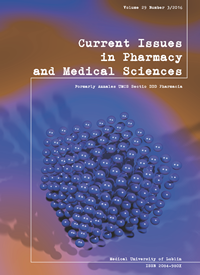Influence of different excipients on the properties of hard gelatin capsules with metamizole sodium
DOI:
https://doi.org/10.1515/cipms-2016-0023Keywords:
release study, metamizole sodium, capsulesAbstract
Metamizole is an effective non-opioid analgesic drug used in the treatment of acute and chronic pain. Due to induced potentially life-threatening blood disorders, metamizole was withdrawn from market in many parts of the world, however, it is one of the most popular analgesics in Poland that is available as an over the counter drug. Patients tend to prefer capsules over tablets, as they are easier to swallow and taste better. The powder-filled capsules also have greater bioavailability and require less excipients, as compared to tablets. Polymic excipients are mainly used in capsule filling, and have influence upon the physico-chemical properties of the hard gelatin capsules and the powder formulation. The aim of the study was to determine whether various combinations of polymers impact the disintegration time and pharmaceutical availability of hard gelatin capsules with metamizole sodium. The results of our work demonstrated that the 80% of all active substance was released in all tested formulations within 15 minutes. Herein, the capsule containing lactose monohydrate had the longest release (4% after 2 min.), while capsules containing mannitol had the fastest release (81.2% after 2 min.). Moreover, the addition of HPMC to capsules with lactose brought about a slight increase in the metamizole release rate, while the addition of PVP 30 to capsules with microcrystalline cellulose slightly accelerated release. This data suggests that the use of different polymers in capsules formulation brings about changes in the physical properties of powders and modifies the release profile of metamizole. In our study, the most preferred formulation was one containing microcrystalline cellulose (good powder properties and fairly fast release).References
1. Augsburger L.L. (1996). Hard and soft gelatin capsules. In:Modern Pharmaceutics,3rd ed. Banker G.S., Rhodes C.T. (editors). New York: Marcel Dekker, Inc.; p. 395.
2. Basak G.W., Drozd-Sokołowska J., Wiktor-Jedrzejczak W.: Update on the incidence of metamizole sodium-induced blood dyscrasias in Poland.J. Int. Med. Res., 38(4), 1374, 2010.
3. Bowman B.J., Ofner III C.M. (2002). Hard gelatin capsules. In:Protein-Based Films and Coatings. Gennadios A. (editor). Boca Raton: CRC Press; p.367.
4. Daraghmeh N. et al.: Co-processed chitin-mannitol as a new excipient for oro-dispersible tablets.Mar. Drugs, 13(4), 1739, 2015.10.3390/md13041739
5. Edwards J. et al.: Single dose dipyrone for acute postoperative pain.Cochrane Database Syst. Rev., 2010. doi:10.1002/14651858.CD003227.pub2.10.1002/14651858.CD003227.pub2
6. Efentakis M., Vlachou M.: Evaluation of high molecular weight poly(oxyethylene) (Polyox) polymer: studies of flow properties and release rates of furosemide and captopril from controlled-release hard gelatin capsules.Pharm. Dev. Technol., 5(3), 339, 2000.
7.European Pharmacopoeia, 7thed. Strasbourg: Council of Europe, 2010.
8. Faqih A.M. et al.: Effect of moisture and magnesium stearate concentration on flow properties of cohesive granular materials.Int. J. Pharm., 336(2), 338, 2007.10.1016/j.ijpharm.2006.12.024
9. Huber M. et al.: Metamizole-induced agranulocytosis revisited: results from the prospective Berlin case-control surveillance study.Eur. J. Clin. Pharmacol., 71(2), 219, 2015.10.1007/s00228-014-1777-8
10. Jalil R., Ferdous A.J.: Effect of viscosity increasing agent and electrolyte concentration on the release rate of theophylline from a HPMC based sustained release capsules.Drug Dev. Ind. Pharm., 19(19), 2637, 1993.
11. Kołodziejczyk M.K., Kołodziejska J., Zgoda M.M.: Ibuprofen release preferences of medicinal products, the market share of excipients vermet of a polymer.Polim. Med., 40(4), 19, 2010.
12. Korzeniowska K., Jankowski J., Jabłecka A.: Nonsteroidal anti-inflammatory drugs.Farm. Współ., 3, 192, 2010.
13. Lahdenpää E., Niskanen M., Yliruusi J.: Crushing strength, disintegration time and weight variation of tablets compressed from three Avicelä PH grades and their mixtures.Eur. J. Pharm. Biopharm., 43, 315, 1997.
14. Luukkonen P. et al.: Rheological characterization of microcrystalline cellulose and silicified microcrystalline cellulose wet masses using a mixer torque rheometer.Int. J. Pharm., 188(2), 181, 1999.
15. Martínez-Martín P. et al.: Efficacy and safety of metamizol vs. acetylsalicylic acid in patients with moderate episodic tension-type headache: a randomized, double-blind, placebo- and active-controlled, multicentre study.Cephalalgia, 21(5), 604, 2001.
16. Murtada A.O., Abdelkarim M.A., Huyam A.M.: The effect of sodium starch glycolate concentration on physical effectiveness of chlorpheniramine tablets.Indian J. Pharm. Educ., 4(1), 47, 2013.
17. Nikolova I. et al.: Metamizole: A review profile of a well-known “forgotten” drug. Part I: Pharmaceutical and nonclinical profile.Biotechnol. Biotechnol. Equip., 26(6), 3329, 2012.
18. Nokhodchi A. et al.: The role of oral controlled release matrix tablets in drug delivery systems.Bioimpacts, 2(4), 175, 2012.
19. Overguard A.B.A. et al.: Patients’ evaluation of shape, size, and color of solid dosage forms.Pharm. World Sci., 23(5), 185, 2001.
20. Patel R., Podczeck F.: Investigation of the effect of type and source of microcrystalline cellulose on capsule filling.Int. J. Pharm., 128, 123, 1996.
21. Shah R.B., Tawakkul M.A., Khan M.A.: Comparative evaluation of flow for pharmaceutical powders and granules.AAPS PharmSciTech., 9(1), 250, 2008.
22. Shlieout G., Arnold K., Müller G.: Powder and mechanical properties of microcrystalline cellulose with different degrees of polymerization.AAPS PharmSciTech., 3(2), 45, 2002.
23. Stegemann S. (2002).Hard gelatin capsules today –and tomorrow, 2nded. Bornem: Capsugel Library.
24. Zgoda M.M.: Aktualnie stosowane substancje pomocnicze w technologii stałych doustnych środków farmaceutycznych.Farm. Pol., 59(17), 890, 2003.
25. Zhang P.Y. et al.: Preparation of poly (vinyl butyral) hollow fiber ultrafiltration membrane via wet-spinning method using PVP as additive.Desalination, 278, 186, 2011.
Downloads
Published
Issue
Section
License
Copyright (c) 2016 Authors

This work is licensed under a Creative Commons Attribution-NonCommercial-NoDerivatives 3.0 Unported License.


